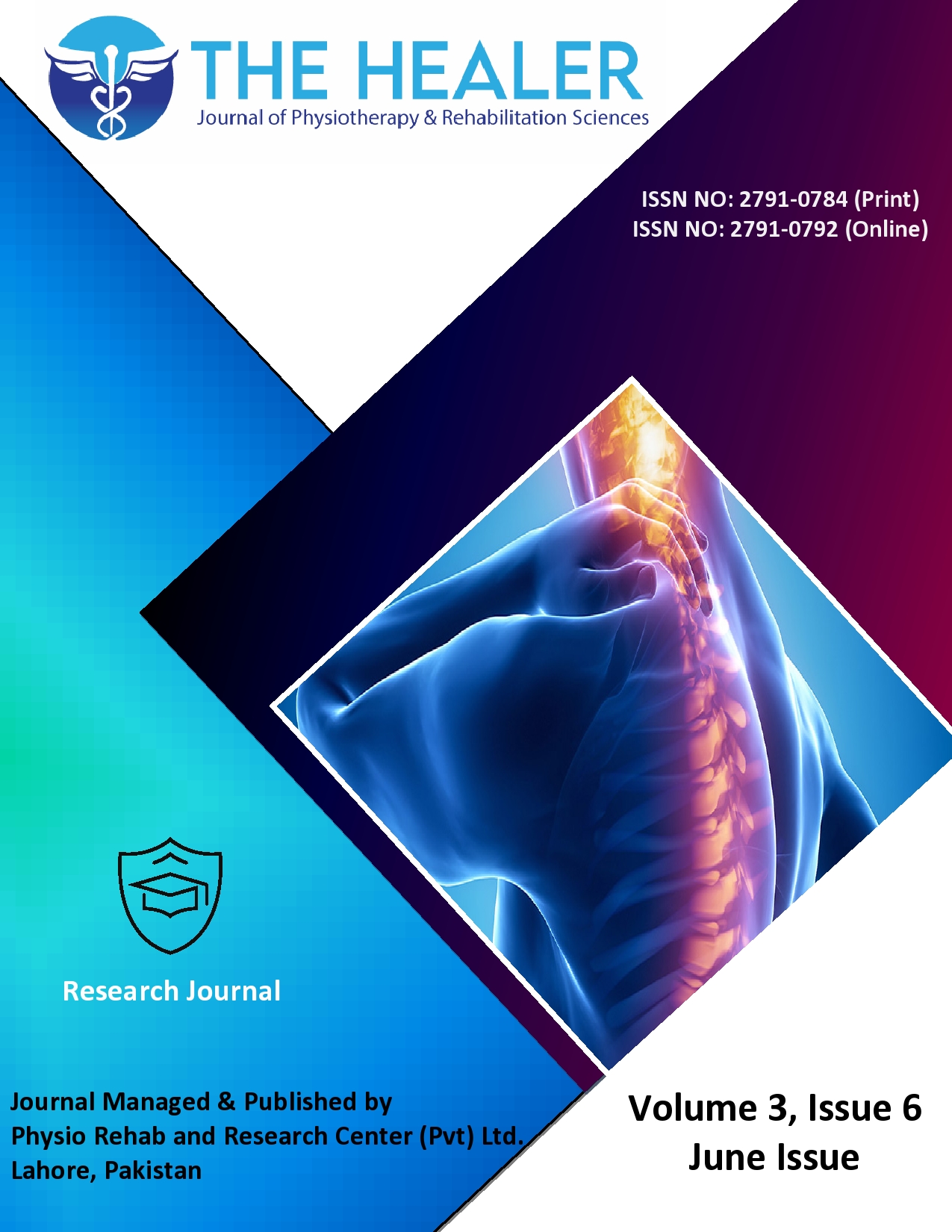Level of Patient Satisfaction with Musculoskeletal Physiotherapy Care in Lahore
Patient Satisfaction with Physiotherapy Care
DOI:
https://doi.org/10.55735/hjprs.v3i6.172Keywords:
musculoskeletal physical therapy, patient satisfaction, physical therapy careAbstract
Background: The evaluation of the quality of care is complex, and patient satisfaction is seen as a crucial component. Over the past three decades, studies into patient satisfaction with care have steadily increased across a variety of specialties, whereas there have not been many studies into patient satisfaction with physiotherapy. Objective: To evaluate the level of patient satisfaction with musculoskeletal physiotherapy care provided by physical therapy departments of different hospitals in Lahore. Methods: This cross-sectional study used information from 74 patients from physical therapy departments of hospitals in Lahore city. Non-probability convenient sampling technique was used. Both male and female patients, aged 18 years or more, with complaints of musculoskeletal disorders were included in this study. However, this study excluded any patients who had neurological issues or mentally and physically challenged patients as well. Twelve questions from the MedRisk instrument for measuring patient satisfaction20 which assesses the quality of care given to the participants. Results were analyzed after the process of data collection using SPSS version 20. The quantitative variables were measured using the mean and standard deviation whereas the qualitative variables were evaluated using numbers and proportions. Results: Out of 74 participants, 56 were men and 18 were women. About 56.2% of them were married as compared to 40.5% who were single. The satisfaction rate was quite high; 75.5% of respondents thought the receptionist was polite, 74.3% thought the registration process was simple, and 79.8% were pleased with the way their therapist had treated them, while the overall satisfaction rate, which was 31.1%, was not great. The final score was 2.33 out of 5, with 5 representing the highest level of satisfaction and 1 the lowest. In addition to this, the analysis also revealed that while only 4.1% disagreed, 74.3% thought the registration process was simple and appropriate. Conclusion: The findings of the study suggest that patient satisfaction levels are moderately high. Physical therapists who do not give their patients enough time seem to be less popular with patients.
Downloads
References
Hush JM, Cameron K, Mackey M. Patient satisfaction with musculoskeletal physical therapy care: a systematic review. Physical therapy 2011; 91(1): 25-36.
Oliveira VC, Refshauge KM, Ferreira ML, et al. Communication that values patient autonomy is associated with satisfaction with care: a systematic review. Journal of Physiotherapy 2012; 58(4): 215-29.
Constand MK, MacDermid JC, Bello-Haas D, Law M. Scoping review of patient-centered care approaches in healthcare. BMC health services research 2014; 14(1): 1-9.
Wijma AJ, Bletterman AN, Clark JR, et al. Patient-centeredness in physiotherapy: What does it entail? A systematic review of qualitative studies. Physiotherapy theory and practice 2017; 33(11): 825-40.
O'Sullivan P, Caneiro JP, O'Keeffe M, O'Sullivan K. Unraveling the complexity of low back pain. Journal of Orthopaedic & Sports Physical Therapy 2016; 46(11): 932-7.
Tennakoon T, de Zoysa P. Patient satisfaction with physiotherapy services in an Asian country: A report from Sri Lanka. Hong Kong Physiotherapy Journal 2014; 32(2): 79-85.
Hush JM, Lee H, Yung V, et al. Intercultural comparison of patient satisfaction with physiotherapy care in Australia and Korea: an exploratory factor analysis. Journal of Manual & Manipulative Therapy 2013; 21(2): 103-12.
Ali N, May S. A qualitative study into Egyptian patients' satisfaction with physiotherapy management of low back pain. Physiotherapy research international 2017; 22(2): e1647.
Rossettini G, Latini TM, Palese A, et al. Determinants of patient satisfaction in outpatient musculoskeletal physiotherapy: a systematic, qualitative meta-summary, and meta-synthesis. Disability and rehabilitation 2020; 42(4): 460-72.
Tallo D. Constructive criticism is essential, but so is praise. Nursing Standard (2014+) 2016; 30(28): 32.
Hall AM, Ferreira PH, Maher CG, Latimer J, Ferreira ML. The influence of the therapist-patient relationship on treatment outcome in physical rehabilitation: a systematic review. Physical therapy 2010; 90(8): 1099-110.
Del Baño-Aledo ME, Medina-Mirapeix F, Escolar-Reina P, Montilla-Herrador J, Collins SM. Relevant patient perceptions and experiences for evaluating quality of interaction with physiotherapists during outpatient rehabilitation: a qualitative study. Physiotherapy 2014; 100(1): 73-9.
Wang C, Weiss DJ, Su S. Modeling response time and responses in multidimensional health measurement. Frontiers in psychology 2019; 10: 51.
Massey P, Prelip M, Calimlim B, et al. Findings toward a multidimensional measure of adolescent health literacy. American journal of health behavior 2013; 37(3): 342-50.
Santana M-J, Feeny D. Framework to assess the effects of using patient-reported outcome measures in chronic care management. Quality of Life Research 2014; 23: 1505-13.
Knight PK, Cheng AN-J, Lee GM. Results of a survey of client satisfaction with outpatient physiotherapy care. Physiotherapy Theory and practice 2010; 26(5): 297-307.
Algudairi G, Al-Eisa ES, Alghadir AH, Iqbal ZA. Patient satisfaction with outpatient physical therapy in Saudi Arabia. BMC health services research 2018; 18: 1-8.
Jahan AM, Rwaiha AE, Gusaibat SR, Al-Ahwal NA, Al-Jafairi ZM, Al-Rashidi MA. Patient satisfaction With physiotherapy services in Libya: a cross-sectional study. Journal of Patient Experience 2021; 8: 23743735211033195.
Ampiah PK, Ahenkorah J, Karikari M. Patients’ satisfaction with inpatient orthopedic physiotherapy services at a Tertiary Hospital in Ghana. Journal of patient experience 2019; 6(3): 238-46.
Beattie P, Turner C, Dowda M, Michener L, Nelson R. The MedRisk instrument for measuring patient satisfaction with physical therapy care: a psychometric analysis. Journal of Orthopaedic & Sports Physical Therapy 2005; 35(1): 24-32.
Hills R, Kitchen S. Satisfaction with outpatient physiotherapy: focus groups to explore the views of patients with acute and chronic musculoskeletal conditions. Physiotherapy theory and practice 2007; 23(1): 1-20.
Hush JM, Yung V, Mackey M, et al. Patient satisfaction with musculoskeletal physiotherapy care in Australia: an international comparison. Journal of Manual & Manipulative Therapy 2012; 20(4): 201-8.

Downloads
Published
License
Copyright (c) 2023 The Healer Journal of Physiotherapy and Rehabilitation Sciences

This work is licensed under a Creative Commons Attribution 4.0 International License.














